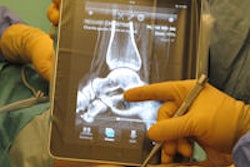
CHICAGO - The spatial resolution of mobile device displays depends, albeit subtly, on their viewing angle, a group from the U.S. Food and Drug Administration (FDA) has found. Details of the study were presented on Monday at RSNA 2013.
After assessing the effect of viewing angle on spatial resolution in a variety of mobile devices, the researchers found that display sharpness decreases slightly when these devices are tilted. The implications of these findings aren't yet clear, however.
"We found [that viewing angle has] a small effect, and we're not saying this is something alarming," said presenter Aldo Badano, PhD. "But we think, if you add this change in sharpness with changes in contrast [from using mobile devices in different lighting conditions], this is something that still needs to be understood in terms of use of these handheld devices for viewing medical images."
Badano presented the research on behalf of lead author Asumi Yamazaki, a doctoral student at Nagoya University's Graduate School of Medicine in Japan.
The availability and usage of handheld devices has increased for a number of reasons, including improvements in quality. One of the key differences, though, between handheld devices and workstation display systems is the various viewing conditions in which they are used, according to Badano.
"The environment changes very dramatically [for handheld devices] as opposed to a workstation where it's fairly controlled," he said. "Also, in terms of the angle, workstations are relatively controlled in terms of the viewing angle that users employ, but with a handheld, there are really no guidelines and there's really not an understanding of how these devices are being used. Are the radiologists actually adjusting the angle to optimize the image quality according to what he or she understands?"
As a result, the FDA team sought to investigate the effect of viewing angle on spatial resolution, or sharpness, in handheld device displays. Seven mobile devices with a variety of sizes and display technologies were included in the study: Apple's iPhone 4 (2010), HTC's Nexus One (2010), Samsung's Galaxy S (2010), Samsung's Galaxy S4 (2013), Apple's third-generation iPad (2012), ASUS' Nexus 7 (2012), and Microsoft's Surface Pro (2013).
The iPhone 4, third-generation iPad, Nexus 7, and Surface Pro had liquid crystal displays (LCDs), while the Nexus One, Galaxy S, and Galaxy S4 had organic light-emitting diode (OLED) displays.
The researchers measured the resolution for each device by displaying a vertical 1-pixel line pattern in portrait orientation in order to calculate its horizontal modulation transfer function (MTF), a measure of sharpness. A photometric CCD camera then captured the screen using a high magnification.
The handheld device orientation was rotated horizontally in 2° increments in the range of -8° to 8°. The researchers then set the devices in landscape configuration and captured the vertical line pattern at the same degree orientations used in the horizontal tests.
The team performed a Fourier transform of the display's line-spread function (LSF) to obtain the MTF for each unit. Of the LCDs, the iPhone 4 suffered the most from angular viewing, but only in the vertical direction. The other LCDs performed fairly well, but some had wider LSFs at ± 8°. MTFs for LCDs moderately decreased as the orientations were tilted up to ± 8°, particularly for the iPhone 4 and the third-generation iPad.
As for the OLED displays, the Nexus One had the widest horizontal LSF at 8° and the sharpest LSF at -8° due to the asymmetric subpixel arrangements utilized in that phone's display. Similarly, the Galaxy S4 had the widest vertical LSF at -8° and the sharpest LSF at 8°, Badano said.
In some other cases, the OLEDs had slightly wider LSFs at -8° and had the sharpest LSF at 8°, although the width variations were minimal, he said.
In other findings, while the horizontal MTF in the Nexus One was most decreased at 8°, the MTF at -8° was close to the highest MTF at 0°. In addition, the Galaxy S4 had the highest vertical MTF at 8°, and its MTF was most decreased at -8°. Otherwise, MTFs tend to be decreased at ± 8° from the highest MTFs at 0°, the group found.
"The OLEDs are a little bit more stable technology with respect to sharpness as a function of the viewing angle," Badano said.
The displays of LSFs are wider at off-normal viewing directions in some handheld devices, and furthermore, MTFs tend to decrease as the device is tilted, he said.
Because the effect of viewing angle on display sharpness was small, Badano noted that the implications of their findings for viewing medical images are unclear and this issue might require further evaluation.




















